Difference between revisions of "White tea"
| Line 1: | Line 1: | ||
[[Image:Bai Hao Yin Zhen tea leaf (Fuding).jpg|thumb|right|250px|White [[Bai Hao Yinzhen tea|Bai Hao Yinzhen]] tea leaves.]] | [[Image:Bai Hao Yin Zhen tea leaf (Fuding).jpg|thumb|right|250px|White [[Bai Hao Yinzhen tea|Bai Hao Yinzhen]] tea leaves.]] | ||
| − | '''White tea''' (Chinese: [[wikt:白茶|白茶]]) is a lightly oxidized [[tea]] grown and | + | '''White tea''' (Chinese: [[wikt:白茶|白茶]]) is a lightly oxidized [[tea]] grown and produced primarily in China. White tea from Fujian province is the most renown. More recently it is also grown in Taiwan, India, Northern Thailand and Eastern Nepal. |
| − | White tea comes from the buds and leaves of the Chinese ''[[Camellia sinensis]]'' plant. The leaves and buds are allowed to wither | + | White tea comes from the buds and leaves of the "Da Bai" [[cultivar]] of Chinese ''[[Camellia sinensis]]'' plant. The leaves and buds are allowed to wither before they are lightly processed to prevent oxidation or further tea processing. |
| − | The name "white tea" derives from the fine silvery-white hairs on the | + | The name "white tea" derives from the fine silvery-white hairs on the leaf shoots of the tea plant, which gives the plant a whitish appearance. The liquor of white tea is pale yellow to light orange depending of type and age. |
== History == | == History == | ||
| − | Scholars and tea merchants generally disagree as to when the first production of white tea (as it is understood in China today) began. What is today known as white tea may have come into creation in the last two centuries. White tea may have first appeared in English publication in 1876, where it is categorized as a [[black tea]] because it | + | Scholars and tea merchants generally disagree as to when the first production of white tea (as it is understood in China today) began. What is today known as white tea may have come into creation in the last two centuries. White tea may have first appeared in English publication in 1876, where it is categorized as a [[black tea]] because it's not immediately after harvest roasted like [[green tea]] to prevent oxidation (kill green). |
| − | |||
| − | |||
| − | |||
| − | |||
| − | |||
=== Catechins === | === Catechins === | ||
| − | White tea contains high levels of catechins, some of which reduce the occurrence of atherosclerotic plaques and the severity of stroke in non-human studies. | + | White tea contains high levels of [[catechins]], some of which reduce the occurrence of atherosclerotic plaques and the severity of stroke in non-human studies. |
== Manufacturing == | == Manufacturing == | ||
| Line 22: | Line 17: | ||
White tea belongs to the group of tea that does not require panning, rolling or shaking. However, the selection of raw material in white tea manufacture is extremely stringent; only the plucking of young tea leaves with much fine hair can produce good-quality white tea with lots of pekoe. | White tea belongs to the group of tea that does not require panning, rolling or shaking. However, the selection of raw material in white tea manufacture is extremely stringent; only the plucking of young tea leaves with much fine hair can produce good-quality white tea with lots of pekoe. | ||
| − | |||
| − | |||
| − | |||
| − | |||
| − | |||
| − | |||
| − | |||
| − | |||
| − | |||
| − | |||
| − | |||
| − | |||
| − | |||
| − | |||
| − | |||
| − | |||
| − | |||
| − | |||
| − | |||
| − | |||
| − | |||
==See also== | ==See also== | ||
Revision as of 14:38, 11 October 2013

White tea (Chinese: 白茶) is a lightly oxidized tea grown and produced primarily in China. White tea from Fujian province is the most renown. More recently it is also grown in Taiwan, India, Northern Thailand and Eastern Nepal.
White tea comes from the buds and leaves of the "Da Bai" cultivar of Chinese Camellia sinensis plant. The leaves and buds are allowed to wither before they are lightly processed to prevent oxidation or further tea processing.
The name "white tea" derives from the fine silvery-white hairs on the leaf shoots of the tea plant, which gives the plant a whitish appearance. The liquor of white tea is pale yellow to light orange depending of type and age.
History
Scholars and tea merchants generally disagree as to when the first production of white tea (as it is understood in China today) began. What is today known as white tea may have come into creation in the last two centuries. White tea may have first appeared in English publication in 1876, where it is categorized as a black tea because it's not immediately after harvest roasted like green tea to prevent oxidation (kill green).
Catechins
White tea contains high levels of catechins, some of which reduce the occurrence of atherosclerotic plaques and the severity of stroke in non-human studies.
Manufacturing
The base process for manufacturing white tea is as follows:
- Fresh tea leaf → Withering → Drying (air drying, solar drying or mechanical drying) → White tea
White tea belongs to the group of tea that does not require panning, rolling or shaking. However, the selection of raw material in white tea manufacture is extremely stringent; only the plucking of young tea leaves with much fine hair can produce good-quality white tea with lots of pekoe.